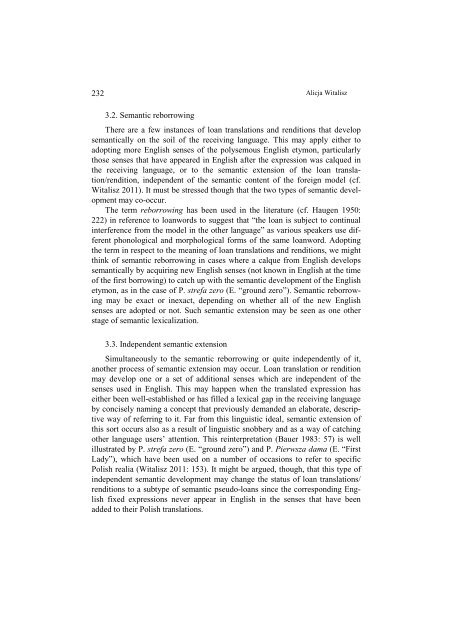s - Wyższa SzkoÅa Filologiczna we WrocÅawiu
s - Wyższa SzkoÅa Filologiczna we WrocÅawiu
s - Wyższa SzkoÅa Filologiczna we WrocÅawiu
Create successful ePaper yourself
Turn your PDF publications into a flip-book with our unique Google optimized e-Paper software.
232<br />
Alicja Witalisz<br />
3.2. Semantic reborrowing<br />
There are a few instances of loan translations and renditions that develop<br />
semantically on the soil of the receiving language. This may apply either to<br />
adopting more English senses of the polysemous English etymon, particularly<br />
those senses that have appeared in English after the expression was calqued in<br />
the receiving language, or to the semantic extension of the loan translation/rendition,<br />
independent of the semantic content of the foreign model (cf.<br />
Witalisz 2011). It must be stressed though that the two types of semantic development<br />
may co-occur.<br />
The term reborrowing has been used in the literature (cf. Haugen 1950:<br />
222) in reference to loanwords to suggest that “the loan is subject to continual<br />
interference from the model in the other language” as various speakers use different<br />
phonological and morphological forms of the same loanword. Adopting<br />
the term in respect to the meaning of loan translations and renditions, <strong>we</strong> might<br />
think of semantic reborrowing in cases where a calque from English develops<br />
semantically by acquiring new English senses (not known in English at the time<br />
of the first borrowing) to catch up with the semantic development of the English<br />
etymon, as in the case of P. strefa zero (E. “ground zero”). Semantic reborrowing<br />
may be exact or inexact, depending on whether all of the new English<br />
senses are adopted or not. Such semantic extension may be seen as one other<br />
stage of semantic lexicalization.<br />
3.3. Independent semantic extension<br />
Simultaneously to the semantic reborrowing or quite independently of it,<br />
another process of semantic extension may occur. Loan translation or rendition<br />
may develop one or a set of additional senses which are independent of the<br />
senses used in English. This may happen when the translated expression has<br />
either been <strong>we</strong>ll-established or has filled a lexical gap in the receiving language<br />
by concisely naming a concept that previously demanded an elaborate, descriptive<br />
way of referring to it. Far from this linguistic ideal, semantic extension of<br />
this sort occurs also as a result of linguistic snobbery and as a way of catching<br />
other language users’ attention. This reinterpretation (Bauer 1983: 57) is <strong>we</strong>ll<br />
illustrated by P. strefa zero (E. “ground zero”) and P. Pierwsza dama (E. “First<br />
Lady”), which have been used on a number of occasions to refer to specific<br />
Polish realia (Witalisz 2011: 153). It might be argued, though, that this type of<br />
independent semantic development may change the status of loan translations/<br />
renditions to a subtype of semantic pseudo-loans since the corresponding English<br />
fixed expressions never appear in English in the senses that have been<br />
added to their Polish translations.
















